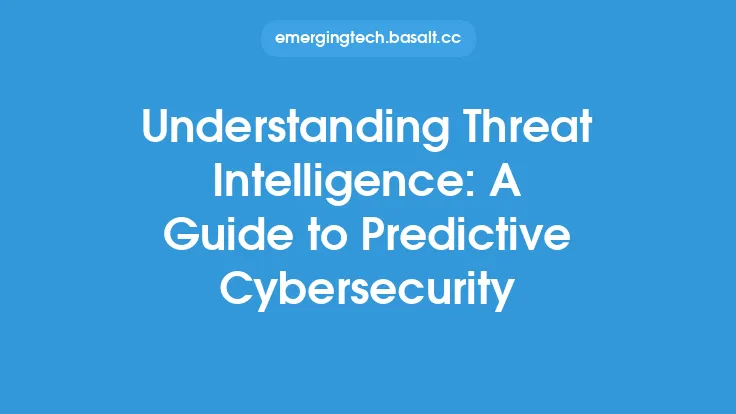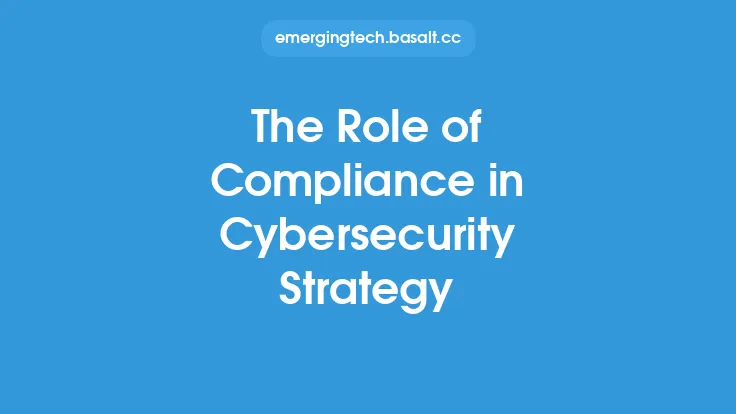Compliance in cybersecurity refers to the process of ensuring that an organization's security practices and protocols adhere to relevant laws, regulations, and industry standards. This is a critical aspect of cybersecurity, as non-compliance can result in significant financial penalties, reputational damage, and increased risk of cyber attacks. In this article, we will delve into the world of compliance in cybersecurity, exploring its importance, key concepts, and best practices for achieving compliance.
Introduction to Compliance Frameworks
Compliance frameworks are structured approaches to achieving compliance with relevant laws, regulations, and industry standards. These frameworks provide a set of guidelines, policies, and procedures that organizations can follow to ensure compliance. Common compliance frameworks include the National Institute of Standards and Technology (NIST) Cybersecurity Framework, the Payment Card Industry Data Security Standard (PCI DSS), and the Health Insurance Portability and Accountability Act (HIPAA) Security Rule. Each framework is designed to address specific compliance requirements, such as data protection, access control, and incident response.
Understanding Compliance Requirements
Compliance requirements vary depending on the industry, location, and type of data an organization handles. For example, organizations that handle payment card information must comply with PCI DSS, while those in the healthcare industry must comply with HIPAA. Compliance requirements can be broadly categorized into three types: regulatory, contractual, and industry-based. Regulatory requirements are imposed by government agencies, such as the General Data Protection Regulation (GDPR) in the European Union. Contractual requirements are specified in contracts or agreements with third-party vendors or partners. Industry-based requirements are established by industry associations or standards organizations, such as the International Organization for Standardization (ISO).
Compliance and Risk Management
Compliance and risk management are closely intertwined. Risk management involves identifying, assessing, and mitigating potential risks to an organization's assets, including data, systems, and infrastructure. Compliance is an essential aspect of risk management, as non-compliance can increase the risk of cyber attacks, data breaches, and other security incidents. Effective risk management involves conducting regular risk assessments, implementing controls and countermeasures, and monitoring compliance with relevant laws, regulations, and industry standards.
Key Components of Compliance
Several key components are essential for achieving compliance in cybersecurity. These include:
- Policies and procedures: Clearly defined policies and procedures provide a framework for compliance and ensure that all employees understand their roles and responsibilities.
- Access control: Implementing access controls, such as authentication, authorization, and accounting (AAA), ensures that only authorized personnel can access sensitive data and systems.
- Data protection: Encrypting sensitive data, both in transit and at rest, protects it from unauthorized access and ensures compliance with data protection regulations.
- Incident response: Establishing an incident response plan ensures that organizations can respond quickly and effectively to security incidents, minimizing damage and ensuring compliance with incident response regulations.
- Training and awareness: Providing regular training and awareness programs ensures that employees understand compliance requirements and can identify potential security threats.
Technical Controls for Compliance
Technical controls are essential for achieving compliance in cybersecurity. These include:
- Firewalls: Firewalls control incoming and outgoing network traffic, preventing unauthorized access to sensitive data and systems.
- Intrusion detection and prevention systems: These systems monitor network traffic for signs of unauthorized access or malicious activity, alerting security teams to potential security threats.
- Encryption: Encrypting sensitive data, both in transit and at rest, protects it from unauthorized access and ensures compliance with data protection regulations.
- Access control lists: Access control lists (ACLs) restrict access to sensitive data and systems, ensuring that only authorized personnel can access them.
- Logging and monitoring: Logging and monitoring network activity, system logs, and application logs provide visibility into potential security threats and ensure compliance with logging and monitoring regulations.
Achieving Compliance
Achieving compliance in cybersecurity requires a structured approach. The following steps can help organizations achieve compliance:
- Conduct a risk assessment: Identify potential risks to an organization's assets, including data, systems, and infrastructure.
- Develop policies and procedures: Establish clear policies and procedures for compliance, including access control, data protection, and incident response.
- Implement technical controls: Implement technical controls, such as firewalls, intrusion detection and prevention systems, and encryption, to protect sensitive data and systems.
- Provide training and awareness: Provide regular training and awareness programs to ensure that employees understand compliance requirements and can identify potential security threats.
- Monitor and review: Continuously monitor and review compliance with relevant laws, regulations, and industry standards, making adjustments as necessary to ensure ongoing compliance.
Conclusion
Compliance in cybersecurity is a critical aspect of protecting an organization's assets, including data, systems, and infrastructure. By understanding compliance requirements, implementing technical controls, and providing training and awareness, organizations can achieve compliance and reduce the risk of cyber attacks, data breaches, and other security incidents. Remember, compliance is an ongoing process that requires continuous monitoring and review to ensure that an organization remains compliant with relevant laws, regulations, and industry standards.





